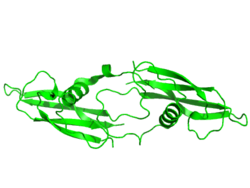

| ARTN | |||||||||||||||||||||||||||||||||||||||||||||||||||
|---|---|---|---|---|---|---|---|---|---|---|---|---|---|---|---|---|---|---|---|---|---|---|---|---|---|---|---|---|---|---|---|---|---|---|---|---|---|---|---|---|---|---|---|---|---|---|---|---|---|---|---|
 | |||||||||||||||||||||||||||||||||||||||||||||||||||
| |||||||||||||||||||||||||||||||||||||||||||||||||||
| Identifiers | |||||||||||||||||||||||||||||||||||||||||||||||||||
| Aliases | ARTN, ENOVIN, EVN, NBN, artemin, ART | ||||||||||||||||||||||||||||||||||||||||||||||||||
| External IDs | OMIM: 603886; MGI: 1333791; HomoloGene: 7631; GeneCards: ARTN; OMA:ARTN - orthologs | ||||||||||||||||||||||||||||||||||||||||||||||||||
| |||||||||||||||||||||||||||||||||||||||||||||||||||
| |||||||||||||||||||||||||||||||||||||||||||||||||||
| |||||||||||||||||||||||||||||||||||||||||||||||||||
| |||||||||||||||||||||||||||||||||||||||||||||||||||
| Wikidata | |||||||||||||||||||||||||||||||||||||||||||||||||||
| |||||||||||||||||||||||||||||||||||||||||||||||||||
Artemin, also known as enovinorneublastin, is a protein that in humans is encoded by the ARTN gene.[5][6]
Artemin is a neurotrophic factor in the glial cell line-derived neurotrophic factor family of ligands which are a group of ligands within the TGF-beta superfamily of signaling molecules. GDNFs are unique in having neurotrophic properties and have potential use for gene therapy in neurodegenerative disease. Artemin has been shown in culture to support the survival of a number of peripheral neuron populations and at least one population of dopaminergic CNS neurons. Its role in the PNS and CNS is further substantiated by its expression pattern in the proximity of these neurons. This protein is a ligand for the RET receptor and uses GFR-alpha 3 as a coreceptor.[5]
Artemin, along with other GDNF family of ligands, has been implicated in the structural development and plasticity of several types of neurons, including ventral mesencephalic dopaminergic neurons.[7] Artemin promotes the survival of newly differentiated neurons after they have undergone terminal mitosis. Artemin has also been found to support the survival neurons in later stages of development and can enhance neuron growth better than neural growth factor during later stages of development.[8] Artemin plays an important role in migration, proliferation, and differentiation of sympathetic neurons during development. However, during target innervation, sympathetic neurons become dependent on neural growth factor for survival support.[9]
Unlike other secreted guidance cues during development, artemin acts solely as a chemoattractant and never acts as a chemorepellent.[10] Artemin is expressed in smooth muscle cells and secreted along blood vessels and in cells near sympathetic axonal projections so that the sympathetic axons can reach their target tissue cells. [10]
This article incorporates text from the United States National Library of Medicine, which is in the public domain.
|
PDB gallery
| |
|---|---|
|
2gh0: Growth factor/receptor complex
2gyr: Crystal structure of human artemin
2ask: Structure of human Artemin
2gyz: Crystal structure of human artemin
|
|
| |
|---|---|
| Neurotrophins |
|
| GDNF family |
|
| Ephrins |
|
| CNTF family |
|
| Other |
|
This article on a gene on human chromosome 1 is a stub. You can help Wikipedia by expanding it. |